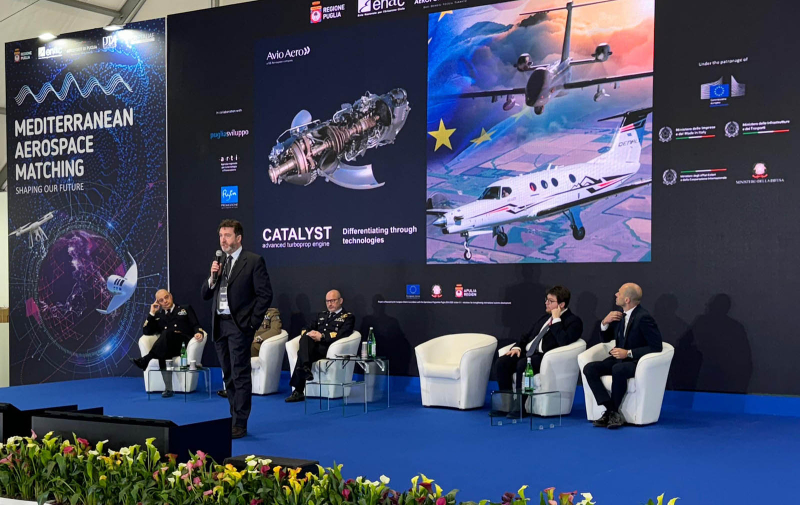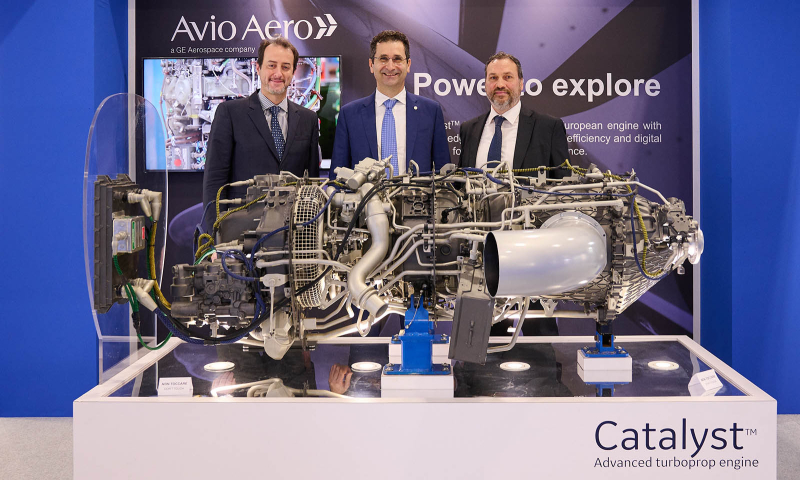Aviation
Mediterranean Aerospace Matching 2024
The event that brought together Italian and foreign aerospace players, together with authorities, researchers, experts and academics to share ideas and technological advances, in the center of the Mediterranean.
Mar 2024
For three days, the Grottaglie-Taranto "Marcello Arlotta" airport has become the Italian "hub" of the aerospace sector. From 20 to 22 March, the Mediterranean Aerospace Matching 2024 took place, the second edition of the international business convention organized by the Aerospace Technology District (DTA) in collaboration with the Puglia Region, ENAC (National Civil Aviation Authority), Aeroporti di Puglia and Criptaliae Spaceport.
In the first two days, the Apulian event focused on remotely piloted aircraft through conferences and various operational activities to simulate the use of multiple drones in a dedicated airspace as part of the “Drones Beyond” initiative. In fact, there have been numerous demonstrations with civilian and military drones to simulate various operational missions: from surveillance to observation, up to inspection to the transport of small loads.
The main companies of the sector (Avio Aero, Leonardo, Boeing Italia and Airbus Italia), space agencies (ASI, ESA), local and regional authorities and institutions, as well as European ones (Clean Aviation, Eurocontrol and EASA) were present at MAM. Differently from the first edition, this year the Italian Armed Forces and Police also participated in the event both with exhibit areas and by attending the panels, joining an important opportunity to deepen the development synergies between the civilian and military worlds.
The speeches ranged over all the themes of MAM, just like drones, space and the potential development plan for Grottaglie airport through the “Spaceport”. The latter is a project also carried out by DTA with the participation of ENAC (National Civil Aviation Authority) which includes, in addition to a hangar and a multifunctional service center designed to accommodate large aircraft, also research spaces for start-ups.
The start-ups promoted by DTA were there in Grottaglie to interact with the main industrial and research players in the sector, both domestic and foreign. Young people and their ideas, with the most innovative start-ups selected for the DTA's investment programme, were able to showcase their skills and abilities. "These virtuous ideas were able to be accompanied by our incubator," said the president of the DTA, Giuseppe Acierno, "to showcase the validity and maturity of their companies leveraging European networking. For this reason, still on the subject of young talents, during the event we also gave space to young high school students from Puglia, Basilicata and Campania regions".
An interesting panel on the second day was the one entitled "Civil and defence UASs: research, innovation, manufacturing technologies" where - together with representatives of Leonardo and Sky Eye Systems for companies and the Army, Navy and Air Force for the Italian Armed Forces - Paolo Salvetti, Head of Turboprop Sales at Avio Aero, participated. In his speech, Salvetti presented the Catalyst, the first turboprop engine entirely developed from a clean sheet and produced in Europe, with its applications both in the civil version (Beechcraft Denali) and in the military version (Eurodrone).
"The Catalyst is a project that makes us particularly proud because it is a tangible example of the investments made in research and development by our company in recent yearsi"
At Avio Aero's exhibit booth at MAM, visitors were able to admire a full-scale 3D printed model of the Catalyst. The display of Avio Aero's European engine aimed also to underline the importance of the Puglia Region, the DTA and the Polytechnic University of Bari in the development of some crucial and innovative components that characterize the Catalyst, such as control systems.
"The Catalyst," said Salvetti, "is a project that makes us particularly proud because it is a tangible example of the investments made in research and development by our company in recent years. This engine is even the result of the virtuous collaboration between Avio Aero and institutions."
Another exhibition area at the Avio Aero stand was dedicated to collaboration with national and local institutions. In fact, infographics were projected through a screen summarizing the implementation objectives and goals achieved through the development contracts signed with the Puglia Region. The latter were funded by the institutions to support the investments made by Avio Aero in the research and development of new technologies, intended for the design and manufacture of aeronautical engine components and the improvement of industrial production processes. In fact, in Puglia, Avio Aero is active between the laboratories in Bari (in partnership with the Polytechnic University of Bari) and the Brindisi plant, a site dedicated to military aircraft engines.
The synergistic relationship with the territory was also well highlighted by the institutional visits that landed at the Avio Aero stand, visited among others by Michele Emiliano, president of the Puglia Region, Alessandro Delli Noci, councillor for Economic Development of the Region, Gianna Elisa Berlingerio, director of the Economic Development Department of the Puglia Region, Francesco Cupertino, rector of the Polytechnic of Bari, and Giuseppe Acierno, president of DTA.







